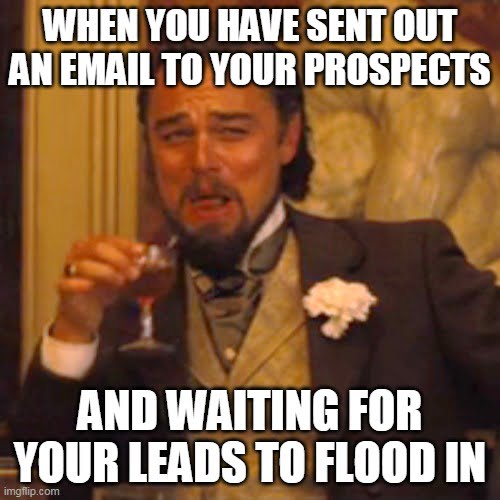Most people think that lead nurturing is just about sending out a few emails to potential customers, but there’s much more to it than that.
In fact, a lot more than that.
If you want your leads to stick around and turn into paying customers, then you need to nurture them in the best way possible. This means providing them with relevant information they can use, and not just trying to sell them at every opportunity.
Here are 10 actionable tips on how you can improve your lead nurturing process and engage with prospects in a way that makes them feel valued.
Let’s first see what lead nurturing is.
What is lead nurturing?
Lead nurturing is a process that entails purposefully engaging your target audience by providing them with relevant information, assisting them in whatever they need, and maintaining a sense of delight throughout the entire buyer’s journey. Because these tactics directly influence a customer’s decision to convert into paying customers, nurturing leads is vitally important for your company’s success.
Targeted content, multi-channel nurturing, multiple touches, timely follow-ups, and personalization are just a few ways to nurture leads.
But why exactly do you need lead nurturing? Let’s see.

Why do you need lead nurturing?
In this new Buyer 2.0 world, building and keeping outstanding relationships is still essential.
Lead nurturing allows you to be present on the channels where your customers are, engage with them, and increase the probability of them starting a business relationship with you.
Lead nurturing also helps your buyers to get to know your business.
It allows you to educate them, inform them, and establish trust with your leads, moving them from the top of the buyer’s funnel (when they aren’t ready to buy) to the bottom (when they are ready to buy).
According to a Marketing Sherpa study, 73% of leads aren’t ready to buy when they give you their contact information.
Leads will be less likely to do business with you if they aren’t ready to buy and your sales team is too aggressive.

The weird clown gif isn’t off-putting enough? Hear this: such misalignment between sales and marketing costs businesses at least $1 trillion each year.
Instead, B2B businesses must figure out how to nurture their leads until they are ready to buy.
According to Annuitas study, nurtured leads have a 47% higher average order value (AOV) than non-nurtured leads.
So, if you want to improve relationships with your customers and generate higher order values, now is the time to consider lead nurturing as a strategy for your business.
Lead Nurturing Tactics
Truth is, there are tons of lead nurturing tactics out there.
But then again, not all of them are the right fit for your business. After all, every company and product is unique.
So, let’s take a look at what your unique business can do to nurture leads better.
1- Fully understand your target customer
Lead nurturing, like all effective marketing techniques, begins with a thorough understanding of your ideal customer.
Knowing your target market thoroughly helps you to discover the most qualified prospects in your pipeline and the most effective ways to connect with them.
You’ll be better able to guide your ideal consumer through the buying funnel if you know what they want and need. That way, lead nurturing can become a powerful tool for converting prospects into customers.
2- Create targeted content for each phase of the buyer’s journey
You already have an outline for this process if you’ve ever mapped out the buyer’s journey.
Examine your buyer’s journey and begin creating content that will benefit your audience at each stage of the buying process.
- Top-of-Funnel Content: Create educational, problem-solving, and question-answering content to support the awareness and discovery phase. Be sure to target popular SEO keywords that prospects look for to rank prominently in search results and generate traffic to your content. Blog articles, videos, infographics, buying guides, and social media content are all examples of top-of-funnel content.
- Middle-of-Funnel Content: When your prospects are in the middle of your funnel—they’re considering whether or not to buy from you. It’s time for marketing content that helps them learn more about what they’ll be getting and how it will help their organization: case studies, landing pages, datasheets, e-books, whitepapers, and webinars all fall into this category.
- Bottom-of-Funnel Content: When prospects are at the buying stage of the buyer’s journey, guide them toward becoming clients. Create bottom-of-funnel content that focuses on buying keywords and guides readers to content that will assist them in making their purchase. Sales pages, free trial sign-up pages, discounts, live demos, testimonials, and FAQ sites are all examples of this type of content.
- Refunneling Content (BONUS!): Create a customer lifecycle marketing plan that supports customers after they’ve made a purchase to take your lead nurturing to the next level. Create material that re-engages customers, assists them with their new purchase, and keeps your brand top of mind so that they keep coming back. Thank you emails, retargeting ads, tailored promotions, and buyer’s guides are examples of retention marketing content.
3- Get on the multi-channel level
Most lead nurturing techniques used to involve creating a simple email drip campaign that sent generic emails to a list of prospects.
Today’s marketers are on the lookout for new strategies and technology that go beyond email nurturing. Marketers are now implementing multi-channel lead nurturing strategies with the support of strong marketing automation platforms.
Among the most common components of effective multi-channel lead nurturing are:
- Marketing automation,
- email marketing,
- social media,
- paid retargeting,
- dynamic website content, and
- direct sales outreach
Because there are so many tactics involved, you’ll need to make sure your sales and marketing teams are well-aligned and work together in order to accomplish this properly.
4- Make sure to have multiple touches
The buyer’s journey is never the same for every customer, but research has suggested that on average ten marketing touches are sent to a prospect before they convert into customers.
That is why you should start reaching out to your prospects not only in conventional ways but also through social media, blog articles, or even email. Let them interact with your company and product even before the acquisition.

5- Watch out for the right timing
Although the benefits of fast follow-up calls appear to be obvious, most businesses are still slow to act.
While automated lead nurturing can help you contact large groups of prospects, the best approach to convert incoming leads into qualified sales opportunities is still to write a timely follow-up email or make a phone call.
That’s because the chances of converting a lead into a sales opportunity increase dramatically when the lead is contacted shortly after a website conversion.
It’s significantly more effective to make a timely, well-planned call to an incoming lead than it is to make a large number of cold calls.
This way you have the opportunity to speak with people that are interested in what your company has to offer and all the information on them is readily available because they’re incoming leads.
6- Launch automated marketing campaigns
Once you have the right content for each stage of the buyer’s journey, set up a marketing automation strategy to deliver targeted messages to the right prospects at the right time.
Marketing automation is a technique that employs software to send material to prospects depending on their quality score, activity, and location in the marketing funnel.
You won’t have to manually track leads or decide what message to send them if you use marketing automation.
When a specific trigger occurs, you build up a system that automatically sends new content to prospects (such as visiting a landing page, filling out a form, clicking a link in an email, etc.).
Many CRM tools can also be used to automate marketing campaigns. Choose a tool that meets both needs when looking for a solution.
7- Keep prospects engaged using social media
The majority of automated marketing initiatives rely on recipients receiving and opening emails.
There are, however, other ways to connect with your audience.
Rather than just sign up for your email list, some people may enter your funnel by following you on social media. And a great way to keep prospects engaged is by sharing engaging posts on them.
Schedule social posts with apps like Buffer, Edgar, or Hootsuite so you don’t have to manually add new ones every day.

8- Draw prospects back with high-quality content
Create quality content so your readers will want to come back for more!
Consistently publishing high-quality posts on your site lets people know you’re a reliable source of information.
Quality content also gets people to share your blog post in their social media network, which drives traffic and builds trust with people who haven’t heard of your site before.
When you only post once in a blue moon, people forget about your blog and probably stop checking for new content. And worst of all, they might not even remember who you are or what your site is about when they do see it again!
Once you establish a reputation for publishing quality content consistently, readers will visit your site again and again because they know they’ll find something worth reading there.
Keep in mind: You don’t have to write 3,000-word posts every time you publish on your blog, writing 1500 long posts is more than enough.
When creating posts, make sure they’re very valuable to people that are primarily aimed at. If it’s not interesting or useful information for your ideal readers, don’t publish it at all! Instead, do some research and write about something that will be of value to your target audience.
One way to figure out what kind of content is worth publishing is by doing keyword research, which can tell you which topics are likely to be searched for in search engines like Google.
Then use those terms as inspiration when writing post titles or choosing keywords.
The goal of any web page should always be “to attract visitors who match their desired audience and to deliver outstanding content that addresses their needs“.
9- Utilize lead scoring
For those who are less familiar with the concept of lead scoring, it is a method of ranking prospects on a scale that indicates the perceived value of each lead to the company.
By giving numeric values to certain website browsing behaviors, conversion events, or even social media interactions, the lead scoring can be integrated into most marketing automation platforms.
The resulting score is used to identify which leads should be followed up on by a salesperson directly and which leads require further nurturing.
10- Make sure marketing and sales work in close contact
Being able to align marketing and sales teams is a precious achievement for any business. Although these teams work in different directions, they rely on each other in a general sense and in lead nurturing too.
That is why you need to start getting your sales and marketing teams closer today.
That is, of course, not to say that these teams are supposed to work as one. Just figure out when to transition the prospects to one team or the other throughout their customer lifecycle. Get them to perform on their respective lead nurturing strategies – like marketing focusing on social media and sales on lead scoring – and you will be successfully nurturing your leads.
Conclusion
You have to nurture leads before they become customers.
Why?
Because lead nurturing is a slow process. You can’t go from lead to customer in one day or even six months. It takes time, patience, and dedication on your part for it all to work out – but the end result will be well worth it!
These 10 tips will set you on the right path and make sure that your lead nurturing process is as effective as possible.
Frequently Asked Questions
What is the nurturing process?
Lead nurturing is a process dedicated to engaging with your possible buyers before and after they become aware of your product, preferably in a multi-channel, well-timed manner.
What is a lead nurturing example?
A good example of lead nurturing can be personalized emails, social media presence, or simple ads that will engage with your future buyers.
What’s the difference between lead generation and lead nurturing?
The difference between lead generation and lead nurturing is that lead generation focuses on finding new leads, while lead nurturing is preparing to engage with such leads.
{“@context”:”https://schema.org”,”@type”:”FAQPage”,”mainEntity”:[{“@type”:”Question”,”name”:”What is the nurturing process?”,”acceptedAnswer”:{“@type”:”Answer”,”text”:”Lead nurturing is a process dedicated to engaging with your possible buyers before and after they become aware of your product, preferably in a multi-channel, well-timed manner.”}},{“@type”:”Question”,”name”:”What is a lead nurturing example?”,”acceptedAnswer”:{“@type”:”Answer”,”text”:”A good example of lead nurturing can be personalized emails, social media presence, or simple ads that will engage with your future buyers.”}},{“@type”:”Question”,”name”:”What’s the difference between lead generation and lead nurturing?”,”acceptedAnswer”:{“@type”:”Answer”,”text”:”The difference between lead generation and lead nurturing is that lead generation focuses on finding new leads, while lead nurturing is preparing to engage with such leads.”}}]}








